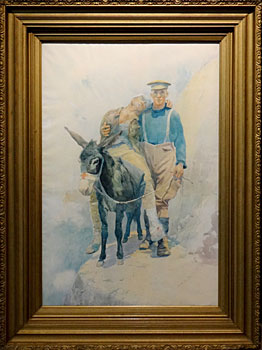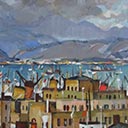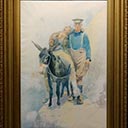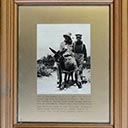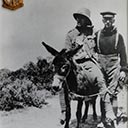Simpson & His Donkey
98 x 65 cm
est. $300,000 - 500,000
PROVENANCE:
Collection of the Commerce Club, Auckland
This is the most significant watercolour of 'Simpson' and his donkey ever to have been presented at auction. This version of the painting was bought from Horace Moore-Jones' widow in 1926 for £300 by the Commercial Travellers' Association of Auckland. It hung in their club rooms in Remuera before it was loaned to the Auckland War Memorial Museum. There it quickly became an important part of their Scars on the Heart exhibition. The painting has long been a popular icon representing the suffering of the soldiers and the humble, selfless service of those who helped others on Gallipoli. Now, just on 100 year later, when we understand the futility and botched military planning that created this disaster, the painting has become an even more important symbol of the compassion men showed for their wounded comrades.
Moore-Jones painted this picture not on Gallipoli but from a photograph he was given when he spoke about the work of the stretcher bearers in Dunedin in 1917. When he told the story of the legendary Simpson who used a donkey to carry the wounded from steep gullies, he said he was sorry not to have a painting or photograph of him.
After the talk Mr G F Jackson approached him and said he had such a photograph - that his brother, who was serving on Gallipoli, had sent it to him. Before he left Dunedin Moore-Jones painted a small watercolour of the photo, which he gave to the family and it is probably this version that is now in the Aigantighe Art Gallery in Timaru.
Moore-Jones believed that he was painting the legendary Simpson, already a folk-hero in Australia. Those who knew the truth, even Dick Henderson, did nothing to contradict this belief. It was not until the 1930s that some of the West Australian soldiers who had served with Simpson said the man in the painting was not their 'cobber'.
Finally Sergeant Jackson, the soldier who had taken the original photograph wrote to Major J L Treloar, director of the Australian War Memorial Museum explaining why he had not said who the subject of the painting was:
What good would come out of it? In the first place the whole value of the lesson learnt by thousands of children from the noble example of Simpson would have been lost. The value of that painting in Auckland would have depreciated to a matter of a few pounds. The illustration in the official war history would have been regarded as a fake….What harm?
The Australians were annoyed that the man they had believed to be Simpson was not that person, but a New Zealander. Even today the version of this painting in the Australian War Memorial Museum is called The Man with the Donkey.
Moore-Jones recreated the scene from the photograph. The stretcher bearer remains the man in the picture - a compassionate, stoic individual who with a Christ-like resolution brings comfort to the injured. The wounded soldier with his head thrown back becomes a symbol of every soldier's suffering and of the chance to live that people like Simpson gave him. Just as important is the small shaggy donkey about the size of a Newfoundland dog who so nobly carried the wounded. The three of them suggest a Renaissance painting of the Holy Family. The path, above a deep ravine, is the amazingly narrow line between death and life which all soldiers faced on Gallipoli.
This painting is the most important Moore-Jones ever auctioned. It is one of the bigger studies of Simpson and it is very similar to the version in the Australian National War Memorial Museum. When Moore-Jones painted it in Auckland, it was one of the two versions that was sent to Britain to be reproduced as a print. The two were sent on separate ships in case one was torpedoed on the voyage. Hundreds of copies were made and they were widely displayed in Australia and New Zealand. It was this which reinforced the importance of Simpson and his Donkey - the symbol of the compassionate man who brought help to so many amidst the slaughter.
JENNIFER HAWORTH: Author of Behind the Twisted War - A Study of New Zealand Artists in World War I & The Art of War - New Zealand War Artists in the Field 1939 - 1945. Wily Publications

